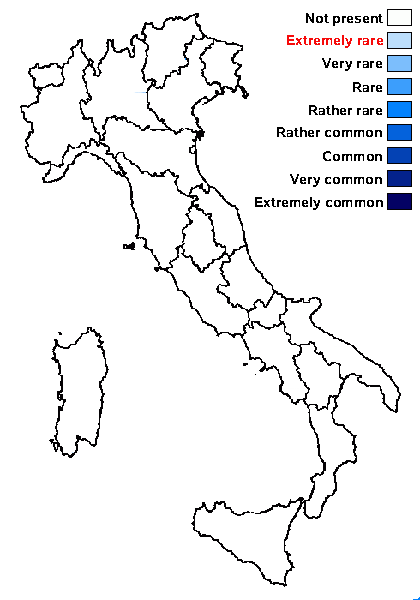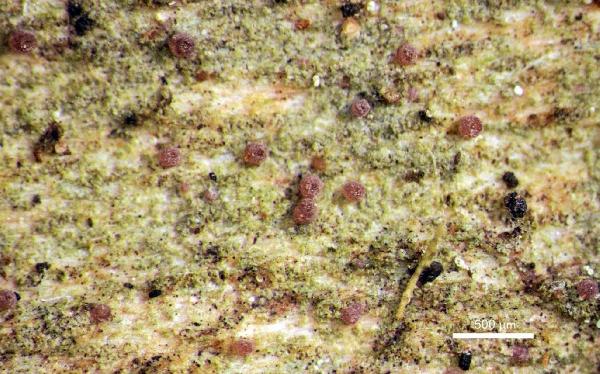Micarea tomentosa Czarnota & Coppins
in Czarnota, Polish Bot. Stud., 23: 174, 2007.
Synonyms:
Distribution:
Description: Thallus crustose, episubstratic, bright green, consisting of 30-50 µm wide granules formed by confluent, 10-15 µm wide goniocysts with a hyaline gel-matrix. Apothecia micareoid, emarginate, pale, faintly brown, pink-brown or straw-coloured, convex to hemispherical, more or less adnate, 0.15-0.3 mm across. Proper exciple poorly developed (in basal parts of the apothecia) to absent; epithecium colourless to faintly straw-coloured, K-, C-; hymenium colourless, 35-40 µm high,; paraphyses scanty, 1-1.5(-1.7) µm wide, sparingly branched and anastomosing in upper part, the apical cells to 2(-2.4) µm wide; hypothecium colourless, c. 70 µm high. Asci 8-spored, clavate to cylindrical-clavate, with a K/I+ pale blue apical dome with a dark blue tubular structure, 30-35 x 7-9 µm. Ascospores (0-)1-septate, hyaline, oblong-ellipsoid, or oblong, (6.5-)7.5-9(-9.5) x 2.2-3.5(-3.75) µm. Pycnidia numerous in sterile forms, at first white, globose and sessile, but soon becoming whitish-grey or pale grey, shortly stalked, with an often widely gaping ostiole, distinctly white-tomentose especially when young, glossy in upper part or with whitish hyphae at base, the wall colourless and K- to brownish straw-coloured to brown and K± violet. Mesoconidia oblong-cylindrical, (3-)3.2-3.5(-3.8) x 1.23-1.5(-1.65) µm. Photobiont micareoid, the cells 4-7 µm wide. Spot tests: thallus K-, C-, KC- , P-; pycnidial walls K- or K+ violet. Chemistry: thallus without lichen substances; Sedifolia grey pigment sometimes present in the pycnidia.Note: a rare, mainly lignicolous species of pristine forests, with scattered records in Central Europe but probably more widespread (Czarnota 2009). To be looked for in Italy.
Growth form: Crustose
Substrata: bark and lignum
Photobiont: green algae other than Trentepohlia
Reproductive strategy: mainly sexual, or asexual by conidia and thalloconidia

Predictive model
Growth form: Crustose
Substrata: bark and lignum
Photobiont: green algae other than Trentepohlia
Reproductive strategy: mainly sexual, or asexual by conidia and thalloconidia

Predictive model


